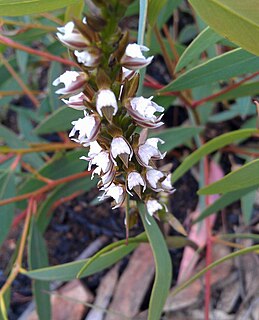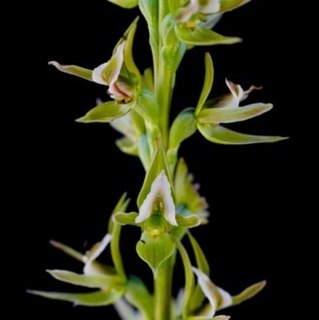
Prasophyllum alpinum, commonly known as the alpine leek orchid, is a species of orchid endemic to Tasmania. It was formerly described as occurring in mainland Australia but has smaller flowers than the species occurring there. It has a single, tube-shaped leaf and up to fourteen green to greenish-brown flowers and grows in subalpine areas.

Prasophyllum affine, commonly known as the heathland leek orchid or Jervis Bay leek orchid, is a species of orchid endemic to New South Wales. It has a single tubular, green leaf and up to fifty scented, green, red, brown and purple flowers. Although the type specimen was collected in the Sydney area in 1803, the species in now only known from three locations near Jervis Bay.
Prasophyllum amoenum, commonly known as the dainty leek orchid or Snug leek orchid, is a species of orchid endemic to Tasmania. It has a single tubular, green leaf with a purplish base and between five and twelve light green, dark brown and white flowers. In 2007, the entire population was estimated to be about 600 plants.

Prasophyllum brevilabre, commonly known as the short-lip leek orchid, is a species of orchid endemic to south-eastern Australia. It has a single tubular, green leaf and up to thirty small, greenish-brown flowers with a white labellum. The labellum is sharply turned back on itself so that its tip almost reaches its base.

Prasophyllum montanum, commonly known as the mountain leek orchid, is a species of orchid endemic to eastern Australia. It has a single tubular, green leaf and up to fifty scented, greenish to pinkish flowers. It grows in montane ecosystems at altitudes above 1,500 m (5,000 ft).
Prasophyllum campestre, commonly known as the sandplain leek orchid, or inland leek orchid, is a species of orchid endemic to eastern Australia. It has a single tubular, yellowish-green leaf and up to twenty greenish, strongly scented flowers with red, purplish, brown or white marks. It grows in the drier parts of Queensland, New South Wales and Victoria.
Prasophyllum apoxychilum, commonly known as the tapered leek orchid, is a species of orchid endemic to Tasmania. It has a single tubular, green leaf with a purplish base and up to twenty light green and whitish flowers. It is very similar to P. truncatum, and there is some doubt as to whether the two species are distinct. The species is known from twenty widely separated populations and is usually only seen in disturbed sites, such as after fire.

Prasophyllum caudiculum, commonly known as the Guyra leek orchid, is a species of orchid endemic to a small area of northern New South Wales. It has a single tubular, bright green leaf and up to thirty five greenish to reddish-brown flowers crowded along an erect flowering stem. It grows in grassy places near Guyra.

Prasophyllum dossenum is a species of orchid endemic to a small area of northern New South Wales. It has a single tubular, dark green leaf and up to thirty scented pinkish-white and greenish-brown flowers crowded along an erect flowering stem. It is a rare orchid which grows in grassy places on the Northern Tablelands of New South Wales.
Prasophyllum milfordense is a species of orchid endemic to Tasmania. It has a single tubular, dark green leaf and up to thirty greenish-brown, white and purplish flowers. It is a very rare orchid, only found in a single location with a population of around 240 plants.

Prasophyllum solstitium is a species of orchid endemic to the Northern Tablelands of New South Wales. It has a single tubular, bright green leaf and up to thirty five greenish-pink to purplish-red flowers crowded on the flowering stem. It grows in grassland on heavy basalt soil.

Prasophyllum patens, commonly known as the broad-lipped leek orchid or sandstone leek orchid, is a species of orchid endemic to the Sydney region of New South Wales. It has a single tubular green leaf and up to thirty green to greenish-brown, lemon-scented flowers with a white labellum.
Prasophyllum robustum, commonly known as the robust leek orchid, is a species of orchid endemic to Tasmania. It has a single tubular, green leaf and up to thirty greenish-brown flowers with a white labellum. It is only known from a single population of about fifty plants, its numbers having been reduced by land clearing.
Prasophyllum rostratum, commonly known as the slaty leek orchid, is a species of orchid endemic to Tasmania. It has a single tubular leaf and up to twenty five well-spaced, greenish-brown flowers. It is similar to P. pyriforme from mainland Australia but lacks that species' white to pinkish labellum.

Prasophyllum tunbridgense, commonly known as the Tunbridge leek orchid, is a species of orchid endemic to Tasmania. It has a single tubular, bright green leaf and up to twenty five relatively large, green to light greenish-brown flowers with white petals and a large white labellum.
Prasophyllum crassum is a species of orchid endemic to South Australia. It has a single tube-shaped leaf and up to fifteen greenish and pinkish-brown flowers with a whitish labellum. It is a recently described plant, previously included with P. fitzgeraldii, but distinguished from that species by its smaller number of smaller, less colourful flowers and different labellum shape. It grows in the south-east of the state and usually only appears after fire.
Prasophyllum tortilis is a species of orchid endemic to South Australia. It has a single tube-shaped leaf and up to ten purplish-brown and green flowers with a purple labellum. It is a recently described plant, previously included with P. fitzgeraldii, but distinguished from that species by its smaller number of smaller, more darkly coloured, short-lived flowers. It also resembles P. goldsackii but has fleshier flowers than that species.
Prasophyllum stygium, commonly known as the elfin leek orchid, is a species of orchid endemic to Victoria. It has a single tube-shaped leaf and up to twenty greenish-brown flowers with a white labellum. It is a recently described plant, previously included with P. fitzgeraldii, but distinguished from that species by its greenish-brown flowers with their white labellum and narrower brown callus. It is only known from a single population of about thirty plants.
Prasophyllum secutum, commonly known as the northern leek orchid, is a species of orchid endemic to Tasmania. It has a single tubular, green leaf and up to thirty scented, light brown flowers with a whitish labellum. It is only known from 18 populations and the total population is estimated to number fewer than 500 plants.

Prasophyllum basalticum is a species of orchid endemic to New South Wales. It has a single tubular, dark green leaf and up to fifteen scented, greenish-brown to brownish-red flowers with a white and green labellum. It grows in grassy woodland on the Northern Tablelands.










